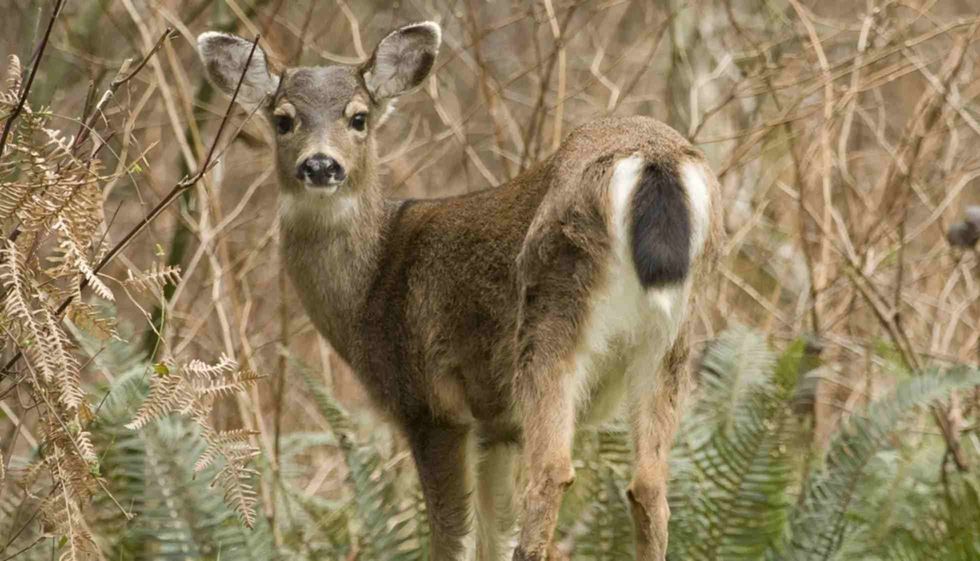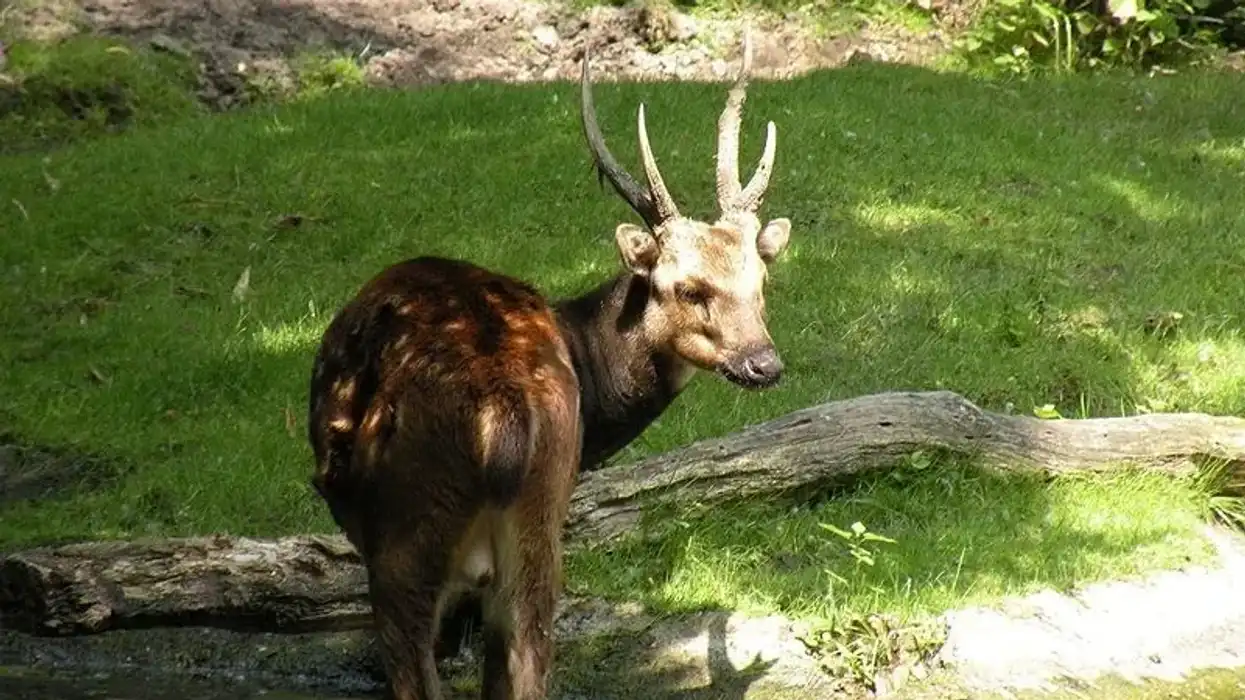A source of constant fascination for hunters, naturalists, and backyard wildlife watchers, this deer earned the nickname of the 'Ghost of the Pacific' for its skillfulness to move unseen and unheard through the thick rainforests.
This popular game animal for hunting has other common names like the Columbian black-tailed deer (Odocoileus hemionus columbianus) and Blacktail deer. There is an argument among scientists on whether or not to make the mule deer a species of its own or keep it as a subspecies of the mule deer.
All authorities observe this deer as a subspecies of the Mule deer, another being the Sitka black-tailed deer that is commonly seen in Southeast Alaska.
A member of the mule deer family, the Blacktail deer, is found across the Pacific Northwest of North America. It is usually active in the early hours of the night and early morning.
As they browse around forests, grassy areas, and golf courses on both sides of the road, exercise caution while driving because, more often than not, if one deer crosses, another one follows.
Read on for more fun facts about Black-Tailed Deer, and do check out deer and reindeer facts for more interesting articles.
Black-Tailed Deer Interesting Facts
What type of animal is a Black-Tailed Deer?
The Black-tailed deer (scientific name, Odocoileus hemionus columbianus) is an elegant mammal, one of the nine species of mule deer. It has two subspecies, the Sitka black-tailed deer (Odocoileus hemionus sitkensis) and the Columbian black-tailed deer (Odocoileus hemionus columbianus).
What class of animal do Black-Tailed Deer belong to?
This Mule deer belongs to the Mammalia class from the family Cervidae. This deer is considered one of the least studied deer species in western North America.
How many Black-Tailed Deer are there in the world?
As this species is not endangered, there is no exact count on how many are left. According to The Western Association of Fish and Wildlife Agencies, it is estimated that the total U.S. mule and blacktail deer population stood at 4.2 million between 2016-2018 and less than 4 million in 2020.
Where do Black-Tailed Deer live?
The Mule deer lives in western North America and Pacific Northwest. The Sitka deer is found in western Oregon, Southcentral Alaska, and Southeast Alaska, including British Columbia, and Kodiak Island. The Colombian black-tailed deer is mainly seen in California (and can also be called the California black-tailed deer), Washington, Oregon, northwards near Alaska, and British Columbia.
What is a Black-Tailed Deer's habitat?
The Black-tailed deer habitat includes dark forests and coastal woodlands. As they do not seem to cover grasslands, deers stay at the edge of the forest. Grasslands are essential not only for food but for the cover as well. Forest edges offer abundant meadows and sufficient shelter.
During the daytime, they rest near streams of water. They spend their time in lower elevations during winter and higher altitudes in the summer. While its cousin Sitka black-tailed deer is seen in coastal British Columbia and Southeast Alaska.
Who does Black-Tailed Deer live with?
Mule deers are usually solitary animals. They spend their time browsing around grasslands. Sometimes, they are seen in small groups active at dusk and dawn.
How long do Black-Tailed Deer live?
The Columbian Black-tailed deer (Odocoileus hemionus columbianus) lifespan is around 9-10 years in the wild, and they can live up to 17-20 years in captivity.
How do they reproduce?
The Black-tailed deer range for the breeding season is between November to December; this breeding season is also known as the rutting season. During this time, the bucks chase the female back and forth across the road, and the female prefers males with big antlers.
The females give birth to two fawns, rarely to one or three fawns. The fawn weighs around 6-8.8 lb (2.7-4 kg) at the time of birth.
They are left alone when the mother goes to browse in its natural habitat, which is crucial to produce sufficient milk for the fawns. They reach sexual maturity around 16 months of age.
What is their conservation status?
This hunting game animal is classified as Least Concern as there is no imminent danger to their population. However, the slowly declining numbers of these deer from 4.6 million in 2000 to less than 4 million in 2020 is a cause of concern to many wildlife researchers and agencies.
The biggest reasons for this decline are attributed to fragmentation and habitat loss.
Black-Tailed Deer Fun Facts
What do Black-Tailed Deer look like?
One of the exciting features this Columbian black-tailed deer buck (Odocoileus hemionus columbianus) has is that its coat colors change as per the seasons. They are brownish-gray in winter and reddish-brown in summer, with their tail always dark brown or black with a white undersurface.
They have stocky bodies with slim, long, and sturdy legs. Their antlers are shed between January and March, and they grow back between April and August. Most often, only Mule bucks have antlers, and female deers may have antlers in rare cases.
Their ears move independently, and with good eyesight, they can see as far as 2,000 ft (600 m). This hearing and sight ability helps them spot you before you can spot them.

How cute are they?
These forest-hunting game bucks and does are generally good-looking, especially the baby deer coming into the world at less than 10 lb in weight. These newborns do not have a sense of smell for a few days since birth; this helps their mothers to keep them safe at a place when they go looking for food.
These species develop antlers called antler buttons as they get six to eight months old under a velvet layer of skin. These antlers become full-size in four to five years.
How do they communicate?
The Columbian black-tailed deer uses more than 10 separate vocalizations to communicate in the forest. They are louder than Rocky Mountain Mule Deer, making rut snorts followed by loud grunts.
Their excellent sense of sight and smell are used to communicate alarm, mutual recognition, and even to leave a scent trail when they travel as they can produce different scents. They are also very good at picking up unusual sounds that signal danger.
How big is Black-Tailed Deer?
The Black-tailed deer size can stand up to 3 ft (1-1.5 m) at the shoulder. The Mule deer is a medium-sized deer compared to the whitetail deer, but their antlers take patterns more similar to the mule deer. The antlers of Mule deer grow into a distinctive double-fork shape.
How fast can Black-Tailed Deer run?
The Mule deer can reach up to 50 mph in speed. If you plan to pursue this deer, don't forget to carry a pair of good shoes.
How much do Black-Tailed Deer weigh?
Fully grown bucks can weigh 200 lb (91 kg), and the female Black-tailed deer weight can be 130 lb (59 kg) on average. While its close cousin, Sitka black-tailed deer, weighs the same or a little less.
What are the male and female names of the species?
Adult male deers are called bucks, while adult females are known as does.
What would you call a baby Black-Tailed Deer?
The young Mule deer are called fawns. Although their mothers take care of these fawns very well, their mortality rate remains 45-70%. Does are highly protective of fawns, and humans are seen as predators.
What do they eat?
The Mule deer eats western poison oak, despite its irritant content along with various berries, nuts, herbs, grass, shrubs, acorns, and lots of green foliage. Specifically, they browse western red cedar, forbs, blackberries, apples, maple, fireweed, deer fern, salal, and red huckleberry in the forest.
The Black-tailed deer diet also includes cultivated crops, lichens, and mushrooms, and prefers new plant growth in summer.
The Blacktail deer is a ruminant, meaning it has four compartments in its stomach; it swallows the food first and brings it back to chew later. These ruminant stomachs are helpful if they have to run when attacked.
Are they dangerous?
A little skittish and docile with their stealth and secretive behavior, the Mule deer can escape hunters easily. Aggressive behavior among deers is unusual but not unheard of, but aggressive behavior among the bucks have been observed in the forest.
They very rarely attack humans, mainly when you try to get close to a Black-tailed deer fawn.
Although they are wary of humans, they can become fearless with frequent human encounters. They are clever enough to figure that if your dog is on a leash, it is not a danger to them.
Would they make a good pet?
Deers are considered wild animals, not suitable to be kept as pets. It is even illegal in some regions; California does not allow a deer as a pet.
Did you know...
In the book 'The Oregon Trail' by Francis Parkman, an eyewitness account of the two-day trek from Fort Laramie, Parkman writes of the shooting of an elk, only to realize later that it was Mule deer that was dead. If this was to be believed, the Mule deer once lived in far east Wyoming.
In this case, some specimens are to be found to the east of California.
Yet, it is extreme to think this is possible because it violates everything we know of these deers.
Instead, nearly two centuries later, Francis Parkman identified the larger subspecies of mule deer that is now known as a mule deer. We can only imagine that it must have been tricky to differentiate the mule deer from its coastal Mule deer subspecies.
How can you tell if a Black-Tailed Deer is going to attack?
When a coastal deer is going to attack, it typically tucks its tail tightly against the rump, this can also be a sign of fear, but the aggressive deer will have hair that stands on end usually.
Another key is a heavy, stiff walk, and dropped ears are easy signs of aggression.
To scare the deer away at a time like this, raise both your hands over your head, spread your jacket wide, and wave while screaming; try anything that can make you look bigger to the deer.
If the deer charges, try to grab its most apparent weapon, the bucks' antlers or the front legs of the does as the females do not have antlers.
You can spot bucks with antlers from April to August.
How high can a Black-Tailed Deer jump?
Mule deer can jump an average of 8 ft high. They usually do not risk the jump if they are uncertain due to their poor vertical vision.
Here at Kidadl, we have carefully created lots of interesting family-friendly animal facts for everyone to discover! Learn more about some other mammals including the nyala or greater kudu.
You can even occupy yourself at home by drawing one on our black-tailed deer coloring pages.










